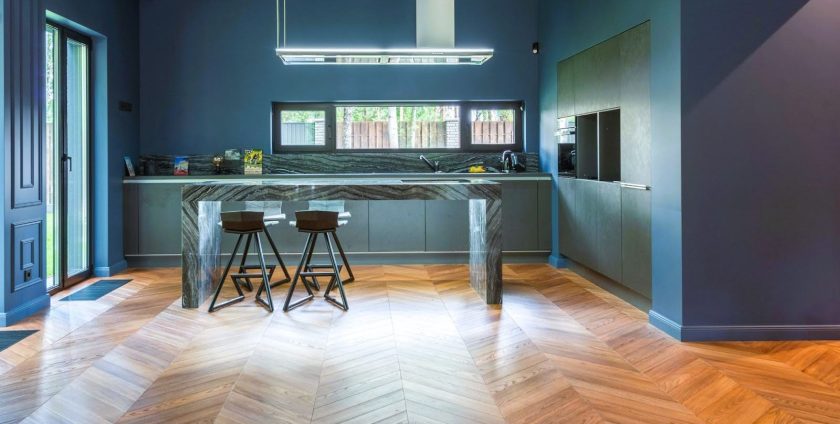
Are you looking for a flooring material that can add a touch of sophistication and elegance to your home without breaking the bank? One of the most unique and attractive options in the market today involves the installation of parquetry flooring.
This floor design has stood the test of time. Records state that it has been used since the 1600’s – with the most notable use case in its history being in the Palace of Versailles and the Parisian Luxembourg Palace. King Louis XIV commissioned it to replace the maintenance-heavy stone floors, and they were often used in grand halls and salons.
From there, the style gained popularity across Europe – and more patterns emerged for the design. And while it did momentarily fall out of fashion in the 1930s, it enjoyed a resurgence in the 1990s, and continues to characterise as a timeless, tasteful design for any standard of interior today.
At Croydon Floors, we understand that looking for the right flooring to invest in can be a daunting task. So, in this article, we will discuss parquetry floors in detail, and why it’s suitable for those looking for sophisticated floor options that won’t break the bank.
What is Parquetry Flooring?
Most modern parquet flooring comes in tile form, in which the wood slats are fixed to a backing material. These strips of wood can be laid straight or diagonally in a repeating pattern. Tiles are then laid side by side to create the preferred pattern, which can be symmetrical or asymmetrical.
The strips of wood used for parquet tiles are hardwood, and can be made from walnut, oak, cherry, pine, maple, and lime.
The benefits of parquetry flooring installation
- Aesthetic Appeal: Parquet floors look sophisticated, and provide visual interest and texture for your floors. Because of this, they’re a popular choice for formal settings like dining rooms, living rooms, and foyers.
- Durability: Parquet floors are structurally sound. With the right care and maintenance, this floor design can hold up for decades.
- Low Maintenance: You wouldn’t need any special cleaning techniques for parquet floors. Simply sweeping and dry mopping it at least once a week would keep it at its best appearance.
- Various options for the wood: There are a variety of parquet tile wood materials you can choose from in the market.
- Easy to install: Parquet tiles are thin, easy to cut, and easy to arrange. They’re also glued to the floor, rather than nailed, so installation is often fast and easy.
Drawbacks of parquet flooring
- Susceptible to marks: The wood can easily be scratched and scuffed, and buffing it out can be difficult. One of the best ways to prevent this is by using area rugs and mats under high-traffic areas or under chairs.
- Unsuitable for damp places: Parquet can warp and be easily damaged in damp places.
- Too busy: The design can be too visually busy in smaller places like bathrooms and kitchens. This can give a cluttered feel to the room.
- Refinishing or repairing can be challenging: It might be challenging to repair these floor tiles because the grain directions are alternating on the tiles. It must be repaired using techniques used to repair hardwood floors like sanding, wood fillers, and colourants.
Types of parquet floor designs
- Herringbone: This style is installed in a V or zigzag pattern. The planks are cut into perfect rectangles and arranged so that the end of one plank touches the side of another.
- Chevron: Much like the Herringbone style, this is also installed in a V pattern. However, the ends of the planks for this style are cut at a 45-degree angle to create a perfect V.
- Mosaic or brick: This is a more modern design where thin wood strips are arranged to form equal-sized squares. These squares are then placed next to one another facing opposite ways.
- Basketweave: As the name suggests, the wood planks are laid out to create a pattern as if they’re woven under and over each other like a basketweave.
- Versailles: This is a high-end parquet design that uses a diamond-shaped weave of wood strips.
- Checkerboard: Here, the wood strips create cubes that make the final design look like a checkerboard.
How to maintain your parquetry flooring installation?
For regular care, use a sweeper or vacuum on your floors to get rid of dust, dirt, and crumbs. If you want to keep them polished, use specifically designed polishes for hardwood floors or parquet floors, and avoid using harsh or abrasive cleaning products. Using as little water as possible to prevent water damage, in addition to this, is ideal – not to mention mopping or drying any excess to avoid lingering moisture.
To prevent your floors from fading too quickly, use curtains to prevent direct sunlight from shining on them for extended periods. If they start looking worn out, it might be time to re-seal them. Ensure that you read the care manual before starting or hire a professional floor expert to do the job right.
Choose the right flooring for your home and have it installed correctly with Croydon Floors. Reach out to us today and get parquet floors that elevate your home now.
- By: Croydon Floors
- Category: Parquetry Flooring
- 0 comment
